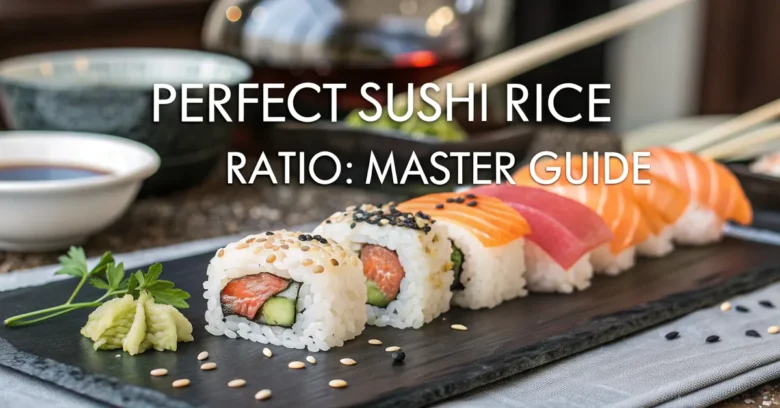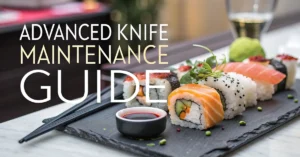Making sushi at home can feel like stepping into a culinary dojo. You’re likely picturing perfectly formed rolls, glistening with a certain je ne sais quoi. But before you even think about the fillings, the seaweed, or the fancy cuts, there’s one thing you absolutely must nail: the rice. It is, without a doubt, the make-or-break element of any good sushi.
The secret to great sushi rice isn’t some ancient technique passed down through generations. It all comes down to the right rice ratio. Mess it up, and you will end up with mushy, sticky globs or rice that’s so dry it crumbles at the slightest touch. Don’t worry, you can learn to do it right, even if you’re just starting out.
This guide will walk you through the art and science of achieving the perfect sushi rice ratio, giving you the knowledge and confidence to create restaurant-quality sushi in your very own kitchen.
Understanding the Sushi Rice Ratio: The Key to Success
The rice ratio refers to the precise proportions of rice, water, and seasoning needed to create authentic sushi rice. This is the bedrock of successful sushi. Get this wrong, and your sushi dreams will likely collapse before you even pick up the rolling mat.
So, what are we aiming for?
Perfect sushi rice should be:
- Slightly sticky: Enough for the grains to cling together without turning into a gluey mass.
- Firm: Each grain should maintain its individual shape.
- Slightly tangy: A subtle sweetness and acidity from the seasoning is important.
- Glossy: With a pleasant sheen thanks to the correct moisture content.
The perfect balance is achieved through careful control of a few key elements.
Unpacking the Core Ingredients: Rice, Water, and Seasoning
Before diving into the exact numbers, it’s important to understand the role each ingredient plays in the final result. Think of it as building a house—each material needs to be just right for a solid foundation.
The Right Rice: Short-Grain Japanese Rice
You might be tempted to reach for any old bag of rice in your pantry. That would be a mistake. Sushi rice demands a specific type: short-grain Japanese rice. Sometimes labeled as “sushi rice” but often available in the Asian aisle of most supermarkets.
Here’s why short-grain rice is king:
- High starch content: This is what gives sushi rice its characteristic stickiness. The starch, called amylopectin, is released during cooking, creating a texture that allows the rice to hold its shape.
- Absorbs water evenly: Short-grain rice plumps up nicely, creating distinct, separate grains that remain firm.
- Slightly sweet flavor: Adds a subtle sweetness that balances the tanginess of the seasoning.
Avoid long-grain rice (like basmati or jasmine) as it won’t have the right starch content, and medium-grain rice, which falls somewhere in between but lacks the distinct characteristics of short-grain.
The Water: Pure and Precise
Water is more than just a cooking medium. It’s a crucial element that determines the texture of the cooked rice. The right amount of water ensures the rice is cooked through without becoming soggy or dry.
Here are a few rules to keep in mind:
- Use filtered water: Tap water can contain minerals and chemicals that affect the taste and texture of the rice.
- Measure carefully: Precision is key here. Use a liquid measuring cup for accuracy.
- Adjust for your pot: Different pots lose moisture at different rates, so you may need to make slight adjustments to the water ratio based on your equipment.
The Seasoning: Sweet, Sour, and Savory
Sushi rice seasoning, also known as sushi-zu, is a simple mixture of rice vinegar, sugar, and salt. This blend does more than just add flavor.
Here’s how it works:
- Rice vinegar: Imparts the signature tangy flavor and helps to preserve the rice. It also contributes to the slightly sticky texture.
- Sugar: Balances the acidity of the vinegar and adds a subtle sweetness.
- Salt: Enhances the flavors and acts as a preservative.
Don’t skimp on quality here. Using good-quality rice vinegar makes a significant difference in the final taste.
The Golden Ratio: Rice to Water to Seasoning
Now for the numbers! This is where you start to transform plain rice into sushi-ready perfection.
Rice to Water Ratio: 1:1 or 1:1.1
The most common and reliable ratio is 1 part rice to 1 part water or 1 part rice to 1.1 parts water.
Let’s break that down:
- For 1 cup of rice: Use 1 cup of water or 1.1 cups of water.
- For 2 cups of rice: Use 2 cups of water or 2.2 cups of water.
The 1:1.1 ratio may be helpful if you feel that your sushi rice turns out too dry, or if your pot loses a lot of moisture during cooking.
Why this ratio works: This proportion allows the rice to fully absorb the water, cooking evenly without becoming mushy. It ensures that each grain is plump and tender.
Seasoning Ratio: Finding the Tangy Sweet Spot
While the rice-to-water ratio is pretty universal, the seasoning ratio can be adjusted to suit your personal preferences. However, a good starting point is:
- For every 1 cup of uncooked rice (yielding about 2-3 cups cooked rice): Use 2 tablespoons of rice vinegar, 1 tablespoon of sugar, and ½ teaspoon of salt.
Adjusting the seasoning:
- Too tart? Add a bit more sugar.
- Too sweet? Add a touch more rice vinegar.
- Not enough flavor? Increase the salt slightly.
The key is to taste and adjust until you achieve a flavor that you love.
Step-by-Step: Cooking Perfect Sushi Rice
Now that you understand the theory, let’s get cooking! This detailed guide will walk you through each step.
Step 1: Rinsing the Rice (The Essential First Step)
Rinsing the rice is not optional. This crucial step removes excess starch from the surface of the grains, preventing the rice from becoming overly sticky during cooking.
Here’s how to do it properly:
- Place the rice in a large bowl: Cover it with cold water.
- Gently swirl the rice with your hand: The water will become cloudy.
- Drain the water: Use a fine-mesh sieve or cheesecloth-lined colander to catch all the grains.
- Repeat the process: Rinse and drain the rice several times until the water runs clear. This usually takes 5-7 rinses.
Why this matters: Rinsing ensures that the rice grains remain distinct and separate when cooked. It is the secret to that perfect sushi rice texture.
Step 2: Cooking the Rice (Stovetop, Rice Cooker, or Instant Pot)
You can cook sushi rice using several methods. Each has its advantages, but the goal is the same: perfectly cooked rice.
Stovetop Method: Classic Control
This method gives you the most control over the cooking process.
- Combine rice and water in a heavy-bottomed pot: Make sure the pot has a tight-fitting lid.
- Bring to a boil over high heat: Once boiling, reduce the heat to the lowest setting, cover, and simmer for 15 minutes.
- Remove from heat: Let the rice stand, covered, for another 10 minutes. This allows the steam to redistribute, ensuring even cooking.
- Fluff with a rice paddle or fork: Gently separate the grains.
Rice Cooker Method: Set It and Forget It
This method is convenient and reliable, especially if you make sushi rice often.
- Combine rice and water in the rice cooker: Follow the manufacturer’s instructions for the water ratio.
- Close the lid and cook: Most rice cookers have a “sushi rice” setting, which is ideal. If not, use the regular white rice setting.
- Let it stand: Once cooked, let the rice stand for 10 minutes before fluffing.
Instant Pot Method: Speedy Solution
This method is quick and efficient.
- Combine rice and water in the Instant Pot: Use the 1:1 ratio.
- Close the lid and set the valve to sealing: Cook on high pressure for 5 minutes, followed by a 10-minute natural pressure release.
- Release any remaining pressure: Open the lid and fluff the rice.
Pro tip: Regardless of the method you use, resist the urge to lift the lid during cooking. This releases steam and can affect the final texture of the rice.
Step 3: Preparing the Seasoning (Blending the Flavors)
While the rice is cooking, prepare the seasoning. This step is simple but crucial.
- Combine rice vinegar, sugar, and salt in a small saucepan: Heat over low heat, stirring until the sugar and salt dissolve completely.
- Remove from heat and let it cool: The seasoning should be at room temperature before you add it to the rice.
Alternative method: If you don’t want to heat the seasoning, you can combine the ingredients in a bowl and whisk until the sugar and salt dissolve. This may take a bit longer.
Step 4: Combining Rice and Seasoning (The Gentle Touch)
This is where the magic happens. The way you combine the rice and seasoning is just as important as the ingredients themselves.
- Transfer the cooked rice to a large, shallow wooden bowl (hangiri): If you don’t have a hangiri, a non-metallic bowl will work. Avoid metal bowls, as they can react with the vinegar.
- Pour the seasoning evenly over the rice: Use a rice paddle or spatula to gently toss the rice, making sure each grain is coated.
- Fan the rice while mixing: Use a fan (or even a piece of cardboard) to cool the rice quickly. This helps to create a glossy sheen and prevent it from becoming too sticky.
- Continue mixing and fanning until the rice is cooled to room temperature: This process can take 10-15 minutes.
Why a wooden bowl? Wooden bowls help absorb excess moisture, preventing the rice from becoming soggy. Fanning the rice cools it down quickly, which stops the cooking process and gives the rice its signature sheen.
Troubleshooting: Common Problems and Solutions
Even with the perfect ratio, things can sometimes go wrong. Here’s how to tackle some common issues:
- Rice is too sticky: You may not have rinsed it enough, or you may have used too much water. Next time, rinse more thoroughly and reduce the water slightly.
- Rice is too dry: You may have used too little water, or your pot may have lost too much moisture during cooking. Increase the water slightly and make sure your lid is tight-fitting.
- Rice is too hard: You may not have cooked it long enough. Extend the simmering time by a few minutes.
- Seasoning is too strong: You may have used too much rice vinegar or salt. Reduce the amount in the next batch.
- Seasoning is not strong enough: You may not have used enough rice vinegar, sugar, or salt. Increase the amount in the next batch.
The best way to improve is to practice, experiment, and adjust until you get it just right.
Beyond the Basics: Tips and Tricks for Sushi Rice Mastery
Want to take your sushi rice to the next level? Here are a few extra tips to keep in mind:
- Use a rice paddle: A wooden rice paddle (shamoji) is ideal for mixing and serving sushi rice. Its flat, broad surface helps to prevent the rice from getting crushed.
- Keep a bowl of water nearby: Dip your hands in water before handling the rice to prevent it from sticking.
- Don’t overmix: Overmixing can make the rice gummy. Be gentle and toss it lightly.
- Use the rice immediately: Sushi rice is best when it’s freshly made. If you need to store it, keep it covered in a cool, dry place.
- Experiment with different vinegars: There are many different types of rice vinegar, each with its own unique flavor profile. Try a few to find your favorite.
- Add Kombu: You can add a small piece of kombu (dried kelp) to the rice while it cooks for extra flavor. Remove the kombu before seasoning the rice.
The Sushi Rice Ratio: A Foundation for Culinary Creativity
Mastering the sushi rice ratio opens up a world of culinary possibilities. Once you’ve nailed the basics, you can start experimenting with different types of sushi.
Here are a few ideas to get you started:
- Nigiri: Hand-pressed sushi with a topping of fish, seafood, or egg.
- Maki: Rolled sushi with seaweed on the outside.
- Uramaki: Inside-out rolls with rice on the outside.
- Temaki: Hand-rolled cones of seaweed filled with rice and toppings.
- Chirashi: A bowl of sushi rice topped with a variety of ingredients.
Don’t be afraid to get creative and experiment with different flavors and textures. The possibilities are endless.
Is Mastering the Rice Ratio Worth It?
Making perfect sushi rice might seem a bit daunting at first. It requires precision, attention to detail, and a bit of patience. But the results are well worth the effort.
With the right rice ratio and a bit of practice, you can create sushi that rivals anything you’d find in a restaurant. Imagine serving up beautifully crafted rolls to your friends and family.
It is doable for anyone who appreciates a good challenge and loves the satisfaction of creating something delicious from scratch. With this guide in hand, you are well on your way to sushi rice mastery!



